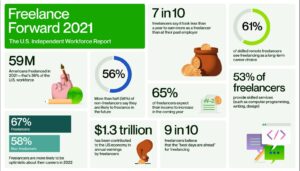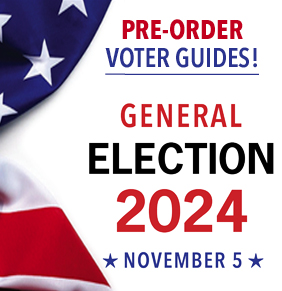
Amendment 1 Proponents Tip Their Hand to Hidden Agenda in Chicago Tribune
Written by John Lopez
This article continues addressing a ballot measure that Illinois voters must vote on this election cycle.
We urge voters to reject Amendment 1, a constitutional amendment that
would elevate collective bargaining rights in the Illinois Constitution,
allowing government union contracts to override state law.
“Hundreds of trucks sit empty in California this week, exacerbating a supply chain crisis already driving the cost of food and goods for all Americans to new heights. California truck drivers took to the streets to protest the state’s new regulation that will destroy their small businesses and effectively draft them into union membership against their will.
“As the pandemic forced us to stay indoors and isolated, unprecedented emphasis was placed on transportation keeping the core systems of our entire supply chain and economy operational and efficient, ensuring freight and key essential workers can continue to move. In a post-pandemic America, we must reevaluate and strategically support our transportation and infrastructure systems and the critical role they play in our lives, our safety and our entire economy.”
— Congresswoman Beth Van Duyne (R, TX-24), Op-Ed, “Livelihoods, safety, economic growth depend on transportation and logistics”, Washington Times, September 14, 2022
The op-ed from the freshman Texas congresswoman of the reality of bad California law sounds ominous.
It is.
Focusing on independent truckers, Congresswoman Van Duyne accurately described what has happened in the state of California since the United States Supreme Court refused to hear the Federal case challenging the California Worker Classification law, known as Assembly Bill 5 (AB5), signed 3 years ago by Governor Gavin Newsom (D), and implemented at the beginning of 2020.
The owner-operator independent truckers’ livelihoods, numbering over 70,000 within the state of California, can no longer legally work in California after the California Trucking Association federal lawsuit failed to be heard by the Supreme Court.
Independent truckers, being 1099 independent contractors, were forcibly reclassified into W-2 employees, and if they wanted to continue to work as over-the-road drivers, they must be hired by a trucking/freight-hauling company, and compelled to join the Teamsters.
Now see what Marc Poulos, the “Vote Yes for Workers’ Rights” campaign committee’s counsel and executive director of the Indiana, Illinois, Iowa Foundation for Fair Contracting, said in the Chicago Tribune article published on Sunday, September 25, with emphasis added:
“It was intentionally drafted to apply to all workers, Poulos said, adding it will cover ‘droves’ of workers not yet protected by federal or state law, such as agricultural workers and independent contractors…”
Now how can the Amendment 1 apply to independent contractors, as well as agricultural workers and “workers not yet protected by federal or state law”?
Illinois Family Action has written about this before concerning independent contractors, back on Labor Day, and Marc Poulos has proven me right.
Review of the Hidden Agenda of Amendment 1 Proponents
Here’s a brief synopsis of the previous articles to oppose Amendment 1. For reference, here’s the wording of the Amendment on the ballot on November 8 with emphasis added:
“Employees shall have the fundamental right to organize and to bargain collectively through representatives of their own choosing for the purpose of negotiating wages, hours, and working conditions, and to protect their economic welfare and safety at work.
“No law shall be passed that interferes with, negates, or diminishes the right of employees to organize and bargain collectively over their wages, hours, and other terms and conditions of employment and work place safety, including any law or ordinance that prohibits the execution or application of agreements between employers and labor organizations that represent employees requiring membership in an organization as a condition of employment.”
Couple with the “employees” reference, per Illinois Senator Ram Villivalam (D-Chicago):
“The Amendment refers to ‘employees,’ and not workers or individuals…done with intention.”
Now what did Villivalam mean when he said, “done with intention”?
State Senator Villivalam’s reference appeared in The Wall Street Journal editorial concerning Amendment 1, published in the August 30, 2022 print edition. Here’s additional context:
“The National Labor Relations Act already governs private workers and limits who can bargain about what. Illinois can’t expand the collective-bargaining rights of private employees beyond what federal law allows.”
While the Journal accurate about the National Labor Relations Act (NLRA) limits governance of private workers and who can bargain for what, something missed was the definition, or “classification” of workers is done at the state level, and the emphasis on any discussion about labor law and the definition of an “employee” can be expanded by state governments, just as was passed in California three years ago this month with Assembly Bill 5 (AB5).
It is the expansion of the definition of “employee” in AB5 the reason over 70,000 independent truckers cannot work in California disrupting the supply chain.
The “done with intention” more proof of the hidden agenda proponents of Amendment 1 trying to do in Illinois.
Marc Poulus proved independent contractors, who are currently not subject to the NLRA, are targets for coverage under Amendment 1 if it passes. Here’s why Poulus’ admission in the Tribune proves proponents’ hidden agenda.
Amendment 1 clearly states “Employees”. The way to broaden eligible workers to be covered under Amendment 1 is to redefine an “employee” through Worker Classification.
States clearly have this right, and thus far, Federal courts have upheld California’s AB5 law. Legal precedent set in mid 2022.
As covered previously, the worker classification test applied to California’s AB5 law is the ABC test, and for reference, here is the three-prong ABC test a worker under AB5 must pass to be classified an independent contractor:
- The worker is free from the control and direction of the hiring entity in connection with the performance of the work, both under the contract for the performance of the work and in fact;
- The worker performs work that is outside the usual course of the hiring entity’s business; and
- The worker is customarily engaged in an independently established trade, occupation, or business of the same nature as that involved in the work performed.
Current Illinois law, outside of the construction industry as well as workers and unemployment compensation, uses the “common law test”, which is used by the IRS, and sometimes referred to as the “IRS test” for worker classification in Illinois.
Why is implementing the ABC test vital to fulfill Amendment 1’s goal for collective bargaining? Because under current Federal law, only a duly classified employee for tax status can be covered under the NLRA, including collective bargaining. Independent contractors cannot take part in union organizing or be covered under a collective bargaining agreement.
Why do proponents, primarily public sector unions, not mention Worker Classification as part of their agenda? Because proponents trying to pass Amendment 1, and if voters approve the November 8 ballot measure, eligible workers for collective bargaining will be increased, armed with the amended Illinois Constitution, to expand eligible workers for union membership, be it in public sector or the private sector, through an expanded Worker Classification law possibly copying California’s AB5 Law use of the ABC test.
As stated above, “current” Federal law, namely the NLRA as well as the Fair Labor Standards Act (FLSA) does not include the ABC test for Worker Classification.
Immediately after California Governor Newsom signed AB5 into law on September 18, 2019, the ABC test from AB5 was copy-and-pasted into a congressional bill known as the “Protecting the Right to Organize (PRO) Act” during the 116th Congress. The PRO Act passed the Democratic controlled House, but failed to be called for a vote in the then-Republican controlled Senate in 2020.
After Democrats flipped the White House and the Senate in 2020, the 117th Congress took up the PRO Act again and in just over a month after an early February, 2021 introduction, the House passed the PRO Act.
The ABC test definitely embedded in the PRO Act (Section 101(B)), along with other provisions including the elimination of right-to-work state laws.
Once the House-passed PRO Act arrived in the Senate in March of 2021, U.S. Senate Majority Leader Chuck Schumer (D-NY) stated he will not bring the PRO Act for a floor vote until at least 50 cosponsors sign-off on the legislation, through cosponsorship of the Senate version of the PRO Act under S. 420.
Since April of 2021, only 47 senators in the Democratic majority have cosponsored the PRO Act. The three Democratic hold-outs are:
- Mark Kelly (AZ)
- Kyrsten Sinema (AZ)
- Mark Warner (VA)
Unless significant re-work, through negotiations, revises the PRO Act, it will likely die in the 117th Congress at the end of the year.
So why are Amendment 1 proponents trying to expand union membership beyond traditional workers?
The reason is clearly in the numbers, and nationwide, according to the Pew Research Center, through 2021, only 10.3% of U.S. workers belonged to a union.
Contrast with the number of independent contractors, according to an Upwork study in late 2020 found 36% of U.S. workers were performing some kind of independent contracting/freelancing, either full time or as a side job. The 36% of workers remained constant in 2021
Additional findings from the Upwork study:
“Freelance” in the context of the Upwork research commissioned through Edelman Intelligence, includes all 1099 independent contractors including:
- Independent Contractors – “Traditional” freelancers who don’t have an employer and instead do freelance, temporary, or supplemental work on a project-to-project basis.
- Moonlighters – Professionals with a primary, traditional job who also do freelance work. For example, a corporate-employed web developer who does projects for non-profits in the evening.
- Diversified Workers – People with multiple sources of income from a mix of traditional employers and freelance work. For example, someone who works part-time at a start-up, manages an Airbnb, and does freelance coding.
- Freelance Business Owners – Freelancers with one or more employees and consider themselves to be a business owner. For example, a marketing guru who hires a team of other marketers to build a small agency, but still identifies as a freelancer.
- Temporary Workers – Individuals with a single employer, client, job, or contract project where their employment status is temporary. For example, a data entry worker employed by a staffing agency who is working on a three-month assignment.
So what’s wrong with the growing number of freelancers/independent contractors, in the eyes of a union? More workers earning significant income outside of the influence of a union means outside of the power & control of union bosses, which is bad news for the political causes unions fund including Planned Parenthood and the Democratic Socialists of America, among others.
In their attempt to bring more independent contractors into union control, the Biden Administration and union proponents, including proponents of Amendment 1, rely on a false narrative the vast majority of contractors are “misclassified”.
Per the U.S. Department of Labor post on June 3, 2022:
“The misclassification of employees as independent contractors is one of the most serious problems facing affected employees, employers and the U.S. economy. Misclassified workers are denied basic workplace protections including rights to minimum wage and overtime pay, making it harder for them to support themselves and their families. Lower pay caused by misclassification reduces workers’ purchasing power, which undermines the entire economy. Meanwhile, employers who comply with the law are at a competitive disadvantage when competing against employers who misclassify employees and pay them less than the law requires and fail to provide other employment-based worker protections.
“For too many workers, misclassification causes lost wages, benefits, unemployment insurance, and workers’ compensation coverage. Even if they recognize that they are misclassified, many employees may be afraid to assert their employment rights because of retaliation. Through its enforcement, the Wage and Hour Division has found misclassification occurs in many industries including construction and health care—even dishwashers have been misclassified.”
The proponents of Amendment 1, like the Biden Administration Labor Department and labor union bosses, believe the above lie. Like most leftists/progressives/socialists, proponents believe government and labor unions should collectively decide how their workers should work.
Legitimate independent contractors, no matter their politics, believe they, as individuals, can negotiate their own wages, hours and provide for their own benefits, with the risks, to be successful.
Classic freedom vs. control, and while bad actors exist, the 59 million workers in the United States choose to work as independent contractors, and if proponents win on November 8, Illinois independent contractors will lose the freedom to market the labor the way they, and not government/unions, believe is the best for them.
More reason, beyond taxes, to reject Amendment 1 — FREEDOM!
Note from John Lopez: The Illinois Economic Policy Institute tweeted a reply to me labeling my linkage of Amendment 1 to Worker Classification as “Misinformation”. After support from friends and fellow freelancers, the ILEPI deleted their tweet, but enough people saw it, and moving forward, I will be screen capturing all hostile tweets on this topic.
John Lopez has written about policy and elections through the McHenry County Blog since 2019 through July 2021. He is now semi-retired, and does freelance work with analytics, as well as political candidates, emphasizing policy as the means to advance the conservative message, by engaging through policy “dog fighting”, applying discernment for winning and advancing God’s Kingdom agenda.
John’s known for getting past the talking points, the narratives, the abstracts, the platitudes and the bromides in order to discuss policy and apply Scripture to overcome unholy divisions in the local community, our state, and nation. John has been married for over 17 years.
Follow John on Twitter: @MarcVAvelar
















